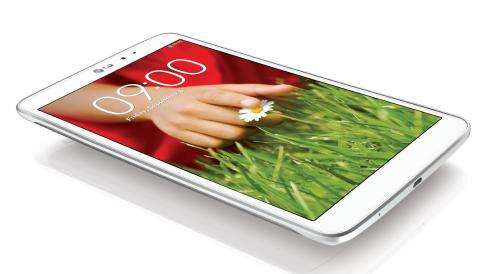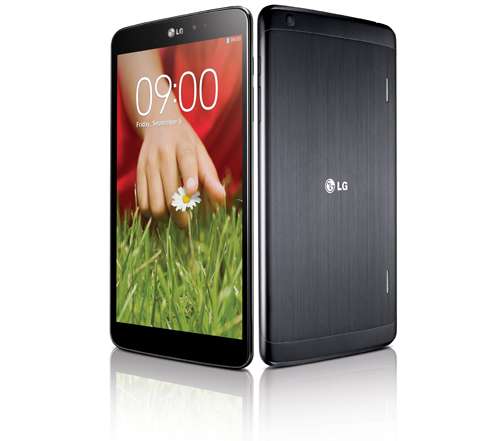For a short time, LG had the distinction of having the rare 8-inch (20-centimeter) tablet with a high-resolution screen. But then Apple came along and stole the spotlight when it unveiled a new iPad Mini with an even better screen.
That doesn't mean you should dismiss LG Electronics Inc.'s new tablet outright, particularly if you have an Android phone. There are a number of features that improve how you work with multiple apps and stay connected without touching your phone—features that other tablet makers ought to consider. These additions, though, aren't enough to distinguish this device as the best tablet for the money.
The new LG G Pad 8.3 has a screen that measures—surprise—8.3 inches (21 centimeters) diagonally. With a screen resolution of 1,920 pixels by 1,200 pixels, it's enough for high-definition video.
It goes on sale in the U.S. starting Sunday for $350—cheaper than the new iPad Mini, which will start at $399 when it comes out later in November. But while the iPad Mini has a smaller screen, at 7.9 inches (20 centimeters), the resolution on that is better, at 2,048 pixels by 1,536 pixels. Google and Amazon also have tablets with high-resolution screens, but at 7 inches (17.5 centimeters). Google's Nexus 7 and Amazon.com Inc.'s Kindle Fire HDX are also much cheaper, at $229.
Unlike the iPad, the G Pad can pair with an Android smartphone with a Bluetooth wireless connection. All you need is the free QPair app from LG. I got it working with LG's G2 phone as well as Samsung's Galaxy S III.
When someone calls your phone, you see who's calling on the tablet. You can choose to reject the call and even text back a reply to say that you're busy.
Texts you get on the phone will appear on your tablet, and you can reply from it. Unfortunately, you're limited to one reply, and you can't initiate a text from the tablet. Another drawback: You can't receive texts with photos or video on the tablet.
Nevertheless, these features are nice to have when you're comfortable on your couch and don't want to bother with answering the phone. You can keep doing what you're doing on the tablet. It's also nice to be able to focus on just one device at a time when multiple gadgets frequently tug at our attention spans.
The iPad also lets you send texts using its Messages app, but it only works with users of other Apple devices. And the iPad doesn't alert you to phone calls.
The G Pad's alerts are similar to what smartwatches such as Samsung's Galaxy Gear are trying to do. But the small screens of smartwatches limit your ability to read and reply to the messages. With the Gear, for instance, text replies are limited to voice dictation that can get garbled in the electronic translation. With the G Pad, you have the luxury of a full on-screen keyboard.
Beyond message alerts, linking the two devices through Bluetooth allows them to sync QuickMemos, or screenshots that you annotate with your finger or a stylus that's sold separately. It's similar to Screen Write feature found on Samsung's new 10-inch (25-centimeter) Galaxy Note tablet. Another feature provides quick access to the app last opened on another device. So if you've been checking out Facebook on your phone, you'll get a quick link to it when you pick up the tablet. One flaw: You have only a few seconds to click, or it disappears.
As for multitasking, the G Pad offers two helpful tools:
— With Qslide, you get easy access to three apps at once. With a slider, you can make two of the apps semi-transparent while working on the third. It just takes a quick adjustment on the slider to make the first two apps reappear in the foreground. This feature makes it possible to be writing an email while retaining quick access to a calculator and Web browser that appear and disappear as you need to reference them. Multiple apps can be running simultaneously on most other Android devices and the iPad, too, but you can see and work with only one at a time. Unfortunately, Qslide for now works with only eight apps, and few of them fit my day-to-day needs.
— With Slide Aside, you can push one of three apps to the side by swiping to the left with three fingers. Swipe to the right to find those hidden apps slide out like a drawer. You then pick the one you want to work with. Unlike Qslide, it worked with all the apps I tried.
Neither tool is as elegant as working with multiple windows on traditional computers, but they begin to address one of my chief complaints with tablets—the inability to juggle multiple programs needed to get something done. Samsung is also starting to build multitasking tools in its Android tablets, and those running Windows 8.1 have the ability to run up to four apps side by side. I'm glad LG is adding some new approaches to the pool.
These multitasking and phone-pairing tools aren't enough on their own, though, to justify the LG's $350 price tag. Although it's cheaper than the new $399 iPad Mini, Apple still has the old Mini, without the high-resolution screen, for $299. If you prefer Android, 7-inch (17.5-centimeter) high-resolution tablets from Google and Amazon are good deals at $229. But if you need 8 inches and Android, the G Pad is the one to consider.
© 2013 The Associated Press. All rights reserved.























